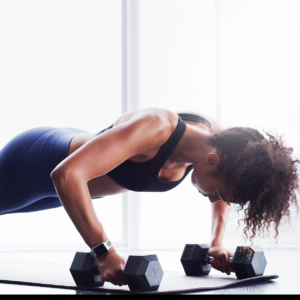Ready to get into the GOOD stuff?! The other week I sent you Part 1 of this blog series, which explained how to calculate your macros. If you haven’t read it yet, please do that first because today we’re going to put those numbers you calculated into ACTION! Go here to catch up!
Knowing and tracking your macros can be game-changing for your metabolism … and will not only accelerate your results but help you to feel and look AMAZING! Before we get started, here are some tips:
TIP 1: Don’t stress about getting your macros exactly right. Use them as ballpark figures vs. trying to be perfect and hitting them exactly. Think of this as a PROCESS of learning, vs. something you have to master right out of the gate.
TIP 2: If you don’t already have an online food journal, you’ll want to create an account at one of the free sites (like MyFitnessPal, Cronometer, FitBit) since they have databases of nutrition info for almost any food.
TIP 3: It’s easier to plan your meals/macros AHEAD OF TIME. Otherwise, you can be left with a weird configuration at the end of the day, wondering what you can eat to hit your numbers.

Ready? It’s time to open up your food journal and map out a day’s worth of eating!
The first few times you do this, it will take a little while but it won’t be long before you can whip up an entire day in just a couple of minutes.
In Part 1, we calculated the macros for someone who is trying to hit 2,000 calories a day and who has a goal of losing fat/gaining muscle:
150 grams of protein a day
55 grams of fat a day
225 grams of carbs a day
In a nutshell, first, you’ll layer in the protein-rich foods for all your meals, then your carbohydrates, and finally add in fats (like salad dressing, butter, etc.), and adjust the amounts once you’ve plugged in all your meals.
As an example, for protein: at breakfast, you would enter “eggs,” at lunch, “tuna,” and for dinner, “chicken breast.” If you use protein powder to make a shake for a snack/post-workout meal, enter that, too!Then, look at how many protein grams that adds up to for the day and see if you’re near the 150-gram mark – but don’t worry about it if you aren’t!

Next, it’s time for the carbs – “starchy” carbs like legumes, quinoa, oats, potatoes, etc. get added in. You’ll find some of your carbs will even bump up your protein number!
Next up it’s veggies & fruits. It can be helpful to shoot for at least one serving at every meal.
Once you’re done with that, it’s time to finetune your plan to get closer to your target macro numbers for the day!
TWEAKING YOUR PLAN:
- A lot of people struggle at first with their protein numbers – they get too little – or their fat numbers – they get too much! The fix: adjust your portion sizes or upgrade your food choices.
NOTE: You’ll get the most benefit out from protein you eat if you spread it out over the course of the day in fairly equal amounts. - It’s helpful to track fiber. According to the USDA, women under the age of 50 should aim for 25 grams a day and men, 38 grams. Women over 50 should try for 21 and men, 30 grams.
If your fiber is low, check your fruit and veggie choices, and also your starchy carbs – adding a ½ cup of legumes (like black beans) can really help. - If your fat number is low, try adding some healthy oil like olive oil to a salad or your veggies, or some healthy fats like nuts and seeds.
What if you want to make a recipe? Many food journals (like MyFitnessPal) let you create recipes and break them down into portion sizes!
I NEED TO KNOW! Are you going to try tracking your own macros? Let me know by texting 916-235-3453






7 Comments
Precise and detailed, you made me know in detail a world that I had only heard about but that intrigued me for the naturalness and strength of its foods.
This is such good stuff! I always struggle with my protein and fat and I am not yet well versed in tracking my anything, but I have kept a food journal and this post has shed some light on how I can just get my portions in! So thanks for this !
I keep hearing people talking about macros and I didn’t really understand it all. Going to check out part one now!
This is a helpful guide. I like how you have explained it making it easy to understand. Although I am satisfied with my current weight (only two pounds off the “ideal weight” for my height), I need to let my daughter know about this. She is overweight, probably brought about by PCOS (polycystic ovarian syndrome). That needs to be addressed first and then she must really start her journey to lose weight. She has my full support on that.
I used to track my macros but maybe for different reasons – it was when I was trying to get a handle on the reactive hypoglycemia I had developed. It takes some getting used to but really does help you understand how you are eating on such a deeper level.
Never heard of this before, but I am deffo interested in this macros, as anything that promotes good wellbeing is a plus from me x
I know people who swear by this method and it is effective. There is a lot of info to learn and understand but it’s the best way to find a balance if you’re struggling to stay on track.